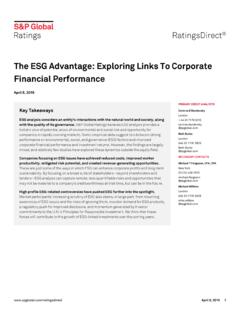Transcription of Coca Cola Company and Industry Profile - RocSearch
1 COCA-COLAI ndustry and Company ProfileAgenda Executive Summary Glossary Industry Profile Global Industry Overview Competitive Landscape -Global Regional Industry Overview Competitive Landscape -US Industry Trends & Drivers Industry Challenges IT Forecast & Trends Company Profile Company Overview Performance Overview Segment Overview Competitor Financial Performance Credit Ratings and Stock Chart Strategic Direction Challenges SWOT Analysis IT Initiatives 3 Executive SummaryGlobal Industry The global beverage Industry has reached a value of US$1, billion, witnessing a CAGR of over 2005-09 and is forecastedto decelerate, with an anticipated CAGR of for the five year period 2009-2014, which is expected to drive the Industry to a value of $1, billion by the end of 2014 In 2009, Food was the largest segment of the global food, beverage and tobacco Industry , accounting for ~67% of the Industry 's total value while the beverage Industry formed 25% of the total Industry value The European and Asia-Pacific industries grew at a CAGR of and respectively, between 2005 and 2009, to reach respective values of US$806 billion and US$ billion in 2009 Seven out of ten global food and beverage companies are based out of US-reflecting the country s strong capabilities in both food products and beverages segments Consumers of the beverage Industry are shifting their focus towards health and wellness.
2 Convenient and innovative products suchas nutrient-enhanced energy drinks, and companies are looking at inorganic growth options to achieve the capabilities for the same The Industry has been heavily relying on technology and IT solutions to attain efficiency in packaging, and distribution management systemsRegional Industry (US) The total US food, beverage and tobacco shipments reached US$ billion in 2010, growing at a CAGR of over the periodspanning 2005-2010 Food product shipments in the US reached US$ billion in 2010, witnessing a CAGR of over the period spanning 2005-2010 Beverage shipment in the US reached US$ billion in 2010, witnessing a CAGR of between 2005 and 2010 Gains in the US beverage Industry are expected to be boosted by new product introductions with novel ingredients that contributeto a healthy lifestyle Though carbonated soft drinks constitute the maximum share in the beverages segment.
3 They are slowly losing this share to non-carbonated sports and health-boosting drinks Almost six out of ten leading food and beverage companies in the US are headquartered at the East Coast adjacent to the shoreIndustry Coca-Cola is a leading non-alcoholic beverage Company with revenues of US$ billion , 500+brands, billion servings per day and presence in nearly 200 countries The Company operates in seven business segments-Eurasia and Africa , Europe, Latin America, North America, Pacific, Bottling Investments and Corporate. The North America Segment is the largest contributor to the revenue while the Europe segment is the largest contributor to the operating income Diverse geographical presence and strong brand equity offers Coca-Cola a distinct competitive advantage.
4 However, high competition and government regulations pose a threat to the Company 's profitability The Company s strategic priorities include driving global beverage leadership; accelerating innovation; and leveraging its balanced geographic portfolio Coca-Cola has been using information systems extensively in all aspects of the business, including RFID in touch-screen vending machines, supply chain management solution, VOIP technology in distribution system, and sales force automationCoca-Cola4 Glossary CAGR Compounded Annual Growth Rate CSD Carbonated Soft Drinks ERP Enterprise Resource Planning IS Information Systems MDM Master Data Management R&D Research & Development RTD Ready-To-Drink SaaS Software As A Service CCECoca-Cola Enterprise s DSPDr Pepper SnappleIndustry ProfileGlobal Food & Beverages Market6 The global beverage Industry s value has increased from US$1, billion in 2005 to US$1.
5 Billion in 2009, representing CAGR of over the four yearsGlobal Industry Overview Food is the largest segment of the global food, beverage and tobacco Industry while the beverage Industry contributes 25% to the total market The beverage Industry grew by Y-o-Y in 2009 to reach a value of US$1, billion at a CAGR of over 2005-10 The European and Asia-Pacific industries grew with CAGR of and respectively, over the same period, to reach respective values of US$ billion and US$ billion in 2009 The Industry is forecasted to decelerate, with an anticipated CAGR of for the five year period 2009-2014, which is expected to drive the Industry to a value of $1, billion by the end of 2014 The European and Asia-Pacific industries are expected to grow with CAGRs of and respectively, over the same period, to reach respective values of $ billion and $ billion in 2014 Global Food & Beverage Industry Market TrendsSource.
6 Datamonitor Global Food Product March 2010, European Securities Network-SNS Securities-Nestle Food, Beverage and Tobacco Market, Food Market Value3,6613,8504,0464,1944,2354,3814,568 4,7805,0225,2550%1%2%3%4%5%6%01,0002,000 3,0004,0005,0006,00020052006200720082009 2010E2011E2012E2013E2014 ETotal Market ValueY-o-Y growthUS$ BillionsGlobal Beverage Market Value1,4281,4691,5141,5481,5821,6181,658 1,6961,7371, ,0001,5002,000200520062007200820092010E2 011E2012E2013E2014 ETotal Market ValueY-o-Y growthUS$ BillionsTotal=US$6, billion7 The Coca-Cola Company is the leading player in the global beverages Industry , generating a share of the Industry 's volume Kraft Foods Inc. is the leading player in the US and second biggest player globally in the food products industryCompetitive Landscape -GlobalSeven out of ten global food and beverage market companies are based out of US-reflecting the country s strong capabilities in both food products and beverages segments Key HighlightsNote: 1) Includes companies in pure-beverage category.
7 2) Includesagricultural raw materials alsoSource:Bloomberg, Freedonia-US Food Industry Overview 2010, US Beverage Industry Overview 2010 Leading Food & Beverage Industry Players1 RankCompanyCountryRevenues (US$ billions)1 Nestle Foods :Bloomberg-Financial Year 2010 DataGlobalFood PacificEuropeRest of the WorldFood & Beverage Industry Geographic Segmentation8 Regional Industry Overview: USThe total US food, beverage and tobacco shipments reached US$ billion in 2010, growing at a CAGR of over the period spanning 2005-2010 The overall food Industry in the US witnessed total shipments of US$ billion in 2010, witnessing a CAGR of over theperiod of 2005-2010, and an annual growth of This includes of food products, of beverages and rest of tobacco products Food products are further broadly categorised as meat & related products, dairy products, grain and oilseed products and other products Beverage products are further broadly classified as soft drinks and ice, breweries, wineries.
8 Distilleries and tea & coffee products Tobacco products are broadly classified as tobacco stemming and re-drying, cigarettes, other tobacco products US food consumption and shipments are affected by macroeconomic variables such as population size and distribution patterns, disposable personal income levels and the overall health of the economyUS Total Food Industry Market HighlightsUS Total Food Shipment Market Value Mix (2010)US Total Food Shipment Market ValueY-o-Y growthUS$ US$ : US Census Bureau9 Segmental Overview: US (1/2)Food product shipments in the US reached ~US$ billion in 2010, at an annual increase of , witnessing a CAGR of over the period spanning 2005-2010 Food shipments in the US reached ~US$ billion in 2010, at an annual increase of The market has witnessed a CAGR of over the period spanning 2005-2010 Shipments of meat and related products totaled ~US$ billion in 2010, based on growth of ~10% from 2009 This segment includes fresh and frozen meat, poultry and seafood processed and prepared packaged foods Other Food products reached US$ billion in 2010, growing at a steady rate over the years This segment includes sugar products such as chocolates, non-chocolate candies.
9 Chewing gum and miscellaneous items such as nuts, peanut butter, dressings and other packaged sauces Dairy product shipments reached US$ billion in 2010 Includes packaged milk, cheese, yogurt, ice cream, condensed milk and similar packed products Shipments of grain and oilseed mill products were US$ billion in 2010 based on the fastest annual pace among the segments This segment includes rice, corn and flour milling; cereals; breads, cookies, baking mixes and certain oilsUS Food Industry Market TrendsFood Industry Segmentation By Product, 201028%44%14%14%Meat &RelatedProductsOtherFoodDairyProductsGr ain &OilseedProductsTotal= US$ Shipment Market ValueY-o-Y growthUS$ BillionsSource: US Census Bureau10 Segmental Overview: US (2/2)Beverage shipment in the US reached US$ billion in 2010, witnessing a CAGR of between 2005 and 2010 Note: 1)Breakdown of 2010 shipments is not availableSource.
10 US Census Bureau, Freedonia-US Food Industry Overview 2010 Beverage shipment in the US reached US$ billion in 2010, witnessing a CAGR of between 2005 and 2010 Gains have been boosted by new product introductions of beverages with novel ingredients that contribute to a healthy lifestyle Soft drinks continue to account for the largest share of beverage production despite eroding market share due to competition from sports drinks and a range of ready-to-drink (RTD) beverages such as energy drinks In 2009, the leading producers of beverages for the US market were Coca-Cola and PepsiCo. Both are expanding their product lines to include beverages that appeal to health-conscious consumers Production volume of beverages in the US grew per annum between 2004 and 2009 to reach billion gallons Production of carbonated soft drinks (CSDs)



